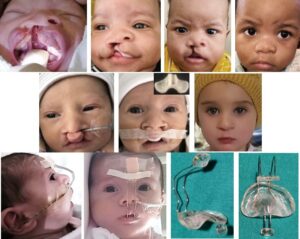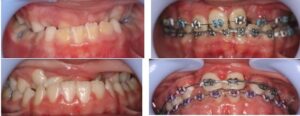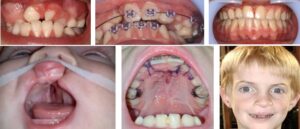Rolanda Prinsloo1*, Çağla Eroğlu2, Kurt-W Bütow3
1Private Practice, Pretoria, South Africa
2Istanbul, Turkey (presently Fellowship in CLP+CFSurg, Bangalore, India)
3Private Practice, Life-Wilgers Hospital, Pretoria, South Africa
Correspondence author: Rolanda Prinsloo, Private Practice, Waterglen, Pretoria, South Africa;
E-mail: [email protected]
Published Date: 26-02-2024
Copyright© 2024 by Prinsloo R, et al. All rights reserved. This is an open access article distributed under the terms of the Creative Commons Attribution License, which permits unrestricted use, distribution, and reproduction in any medium, provided the original author and source are credited.
Abstract
Cleft patients present with a wide clinical spectrum. Deciding on the precise techniques is of utmost importance. There are various surgical procedural treatments, what is critical, is the technique used in the course of the application of Obturpaedic, Orthopaeddontic and Orthodontic treatments. The reason for its importance is that it impacts on the lifelong outcome for the cleft patient and the goal is to obtain the optimal result. Deciding on the most suitable treatment plan is often challenging, especially for patients born with unilateral and bilateral cleft lip, cleft alveolus, cleft hard and soft palate (CLAP) (±41%) and those with a hard and soft palate cleft (hPsP) (±17%), including infants born as a Pierre Robin sequence (±6%) for their survival. Additional cleft anomalies, such as isolated Cleft Lip (CL) (6%), Cleft Lip with Cleft Alveolus (CLA) (±14%) and isolated Soft Palate Cleft (sP) (18%), presents less of a challenge with the application of Obturpaedic, Orthopaeddontic and Orthodontic treatments.
Keywords: Cleft treatment; Cleft in Growing Child; Cleft Lip and Palate; Obturator; Baton
Introduction
The surgical and non-surgical treatments are extensively documented as “Cleft – Ultimate Treatment” [1].
The important concepts of each of the three non-surgical treatment phases in clefts are highlighted and described as:
- Obturpaedic treatment
- Orthopaeddontic treatment
- Orthodontic treatment
It is crucial that these non-surgical treatment phases are implemented at very specific ages. It is critical that the first phase commences immediately after birth, followed by the most active growth period of the patient, up to adolescence. It is essential to continuously evaluate the phase-outcome in order to cultivate individual treatment objectives with the aim of securing the optimal outcome of a particular cleft anomaly.
Three Concepts: The Difference and Their Aim
Obturpaedics Phase
The Obturpaedic treatment, also described as Primary Orthopaedic treatment, Functional Jaw-orthognathic treatment, Cleft-lip moulding and Nasal-alveolar-ala moulding, entails the manufacturing of an extended obturator and a pre-surgical functional jaw orthognathic suction and drinking plate, to assist with feeding and align the congenital rotated alveolar segments in the infant, to decrease the width of the alveolar cleft, palatal cleft and cleft lip and positioning of the prolabium-premaxilla complex in the bilateral cleft anomaly (Fig. 1) [1,2]. Alignment of alveolar segments by narrowing the alveolar cleft and the cleft lip will stimulate the growth of the palatal cleft by keeping the tongue out of the cleft, advance breathing through means of a special type of obturator, often a lifesaving device and also stimulate mandibular growth in a Pierre Robin sequence (Fig. 1) [3]. This treatment decreases the complexity of neonatal surgery for primary mandibular distraction surgery and neonatal tracheostomy, promoting favorable long-term growth, without neck or mandibular surgical scarring and often aids survival after birth [4]. This essential treatment is done before any primary cleft surgical intervention and starts immediately after birth and continues for ± 5 to 7 months.
Orthopaeddontics Phase
In the more severe cleft anomalies, as described in the above-mentioned cleft patients, the midface, mostly the maxilla and nasal structure, falls short mainly in the antero-posterior and medio-lateral dimensions, especially in the more severe median facial dysgenesis [1,5]. This becomes clearly visible with the eruption of the primary teeth. Orthopaeddontics is the EARLY correction of this retrognathic, brevi-retrognathic and longi-retrognathic maxillary deformity, commonly presenting as a Class III and crossbite occlusion with abnormal eruption or occasionally supernummary teeth in the cleft region. This problem requires major paediatric expansion of the maxilla, particularly during this very active and important growing phase of the child, by very actively advancing the cleft-dentoalveolar arches towards the anterior and individually laterally, whilst the mandibula with the dentoalveolar arch is to be held stable in its position (Fig. 2) [6]. Furthermore, in unilateral clefts a midline positioning needs to be achieved for the partially lateral rotated larger dentoalveolar segment. In a bilateral cleft anomaly, the premaxillary dento-alveolar segment must be positioned into the ideal central position and preferably located horizontally and vertically between the lateral cleft dentoalveolar segmental arches of each side (Fig. 2). Active forces with traction elastics are applied to further facilitate the correction of the presented Class III occlusion.
This Orthopaeddontic treatment comprises alignment of primary and permanent teeth on the alveolar ridge(s) in an ideal horseshoe shape, as well as positioning the alveolar segments with the ideal spacing for the bone transplantation, known as the secondary osteoplasty or the secondary osteofusion [1,7]. A stabilisation arch is added to stabilise the movable alveolar segments. Extractions are never performed on primary or permanent teeth during any stage of the Orthopaeddontic phase to create space. This is not applicable to supernummary teeth which may be removed if eruption of normal teeth is hampered or are located in the alveolar cleft.
To achieve the planned result during this Orthopaeddontic phase, before the secondary osteofusion, ideally at ±9 years after ±⅔ facial growth, the dentoalveolar arches will mostly remain and be retained in the correct relationship to each other between the maxilla and mandible with a positive aesthetic result of the midface with usually no further indication of any orthognathic surgery, as a Le Fort I or III osteotomy [7,8]. Depending on the severity of the occlusion and midfacial deformity, Orthopaeddontic treatment commences between 5 to 7 years of age and ends about one to two years after the secondary osteofusion surgery.
Orthodontic Phase
Orthodontic treatment refers to the alignment of teeth, with preferably no orthognathic correction in the cleft patient (Fig. 3). As such any final occlusal and dental aesthetic correction are done during this phase. This phase usually starts at the age of 10 or 11 years.
The major importance in cleft treatment is: if the cleft patient did not receive the comprehensive treatment during the Orthopaeddontic phase, major Orthodontic treatment must be applied, which mostly leads to major cleft-orthognathic surgery. These patients usually present with borderline or compromised velopharyngeal insufficiency and any orthognathic treatment planning needs to consider this aspect of speech production. As such, for maxillary orthognathic surgery, intra-oral distractors or mostly craniofacial distractors need to be applied. These distraction devices are placed for at least a 12 week-period. As a result, two surgical interventions are then performed for the Le Fort I or III osteotomy, to facilitate a Class I occlusion and to establish an acceptable aesthetic midfacial appearance [8]. Alternatively, a compromise treatment can be implemented at times with an anterior mandibular segmental osteotomy and extraction of the 1st or 2nd mandibular premolars during this surgery. The bone-block harvested from the mandibular extraction site is used for paranasal augmentation for a more positive anterior facial balancing. This compromise is an aesthetic and dental improvement, but not an ideal solution. Furthermore, any cleft revision-surgery of the “soft tissue”, cleft rhinoplasty and cleft lip revision, is delayed due to this extended active orthodontic phase, as the correction of the retrognathic midface and/or occlusion takes priority above the soft tissue correction. Often a compromised Orthodontic treatment is necessary and needs to be accepted by the cleft patient, as extraction of permanent teeth, abnormal dental midline, no ideal arch alignment, edge-to-edge anterior occlusion, etc., arises mainly due to the non-implementation or very late comprehensive Orthopaeddontic treatment phase.

Figure 1: a: Obturpaedic treatment – Unilateral CLAP; b: Obturpaedic treatment – Bilateral CLAP; c: Obturpaedics with baton system – Hard & Soft Palate Cleft in Pierre Robin sequence.

Figure 2: a: Orthopaeddontics – Unilateral CLAP; b: Orthopaeddontics – Bilateral CLAP.

Figure 3: a: Orthopaeddontics – Orthodontics [Pre- and Post Osteoplasty] -Unilateral CLAP; b: Obturpaedics – Orthopaeddontics – Orthodontics – Bilateral CLAP.
Conclusion
The treatments in the Obturpaedic and in the Orthopaeddontic phases are paramount for a cleft patient. In the initial phase, the Obturpaedic treatment is important for feeding, alveolar arch alignment and survival in certain syndrome/sequence cases. The treatment in the Orthopaeddontic phase is even more important to utilize the opportunity during the exceptional very active early growing phase of the cleft child for normal alignment of the orthognathic and midfacial system, which involves muscles, skeleton of the face, intra-oral structures and the velopharyngeal complex. Furthermore, it enhances the appearance and dental function with normal eruption of teeth in the cleft arch, without any extractions. Therefore, the total health and appearance of a successfully treated patient with a cleft anomaly is advanced. With the successful completed important Orthopaeddontic treatment phase, the Orthodontic phase should not become a major drawn-out treatment phase and any compromise treatment should absolutely be limited to the utmost minimum, with considerably less orthognathic and facial surgical interventions. The positive outcome for the patient is enormous in terms of continuous phycological trauma due to further facial and occlusal surgical corrections, function of the oral cavity and speech, as well as the financial burden. These applied concepts, not well-known, however, a part of the conventional Orthodontic treatment, indicate a paradigm shift in the comprehensive treatment of patients born with a facial cleft anomaly.
Conflict of Interests
The author has no conflict of interest to declare.
Confirmation of Patient’s or Parent’s Permission
Patient/parent’s permission obtained.
References
- Bütow K, Zwahlen R. Cleft ultimate treatment. 2nd, Reach Publishers’ Services, Wandsbeck, South Africa, 2016; 47-55+251-261.
- Bütow K-W, Zwahlen RA. Primary presurgical treatment for cleft nose, lip, dento-alveolar arches and palate: In Johan Fagan (Editor), Open Access Atlas of Otolaryngology, Head & Neck Operative Surgery. Paediatric Otolaryngology. 2020; https://vula.uct.ac.za/access/content/group/ba5fb1bd-be95-48e5-81be-586fbaeba29d/Primary%20presurgical%20treatment%20for%20cleft%20nose%2C%20lip%2C%20dentoalveolar%20arches%20and%20palate.pdf
- Poets CF, Maas C, Buchenau W, Arand J, Vierzig A, Müller-Hagedorn S. Multicenter study on the effectiveness of the pre-epiglottic baton plate for airway obstruction and feeding problems in Robin sequence. Orphanet J Rare Dis. 2017;12:1-6.
- Du Plessis SM, Van den Berg HJS, Bütow KW, Hoogendijk CF. Airway and feeding problems in infants with Fairbairn-Robin triad Deformities. Curationis. 2013;36.
- Mew J. The cause of malocclusion. Publisher-Printstation Ltd, Blackboys, East-Sussex, England. 2013;1-108.
- Price WA. Nutrition and Physical Degeneration: 7th, Publisher – The Price- Pottenger Nutrition Foundation, La Mesa, CA, USA. 2006;326-81.
- Paglia L. Interceptive orthodontics: awareness and prevention is the first cure. Eur J Paediatr Dent. 2023;24:5.
- Zwahlen RA, Bütow KW. Maxillary distraction resulting in facial advancement at LeFort III level in cleft lip and palate patients: A report of two cases. Oral SurgOral Med Oral Rad, 2004;98:541-5.
Article Type
Review Article
Publication History
Received Date: 29-01-2024
Accepted Date: 18-02-2024
Published Date: 26-02-2024
Copyright© 2024 by Roy Prinsloo R, et al. All rights reserved. This is an open access article distributed under the terms of the Creative Commons Attribution License, which permits unrestricted use, distribution, and reproduction in any medium, provided the original author and source are credited.
Citation: Prinsloo R, et al. Cleft Treatment: Obturpaedics, Orthopaeddontics, Orthodontics-Important Concepts. J Dental Health Oral Res. 2024;5(1):1-5.

Figure 1: a: Obturpaedic treatment – Unilateral CLAP; b: Obturpaedic treatment – Bilateral CLAP; c: Obturpaedics with baton system – Hard & Soft Palate Cleft in Pierre Robin sequence.

Figure 2: a: Orthopaeddontics – Unilateral CLAP; b: Orthopaeddontics – Bilateral CLAP.

Figure 3: a: Orthopaeddontics – Orthodontics [Pre- and Post Osteoplasty] -Unilateral CLAP; b: Obturpaedics – Orthopaeddontics – Orthodontics – Bilateral CLAP.


